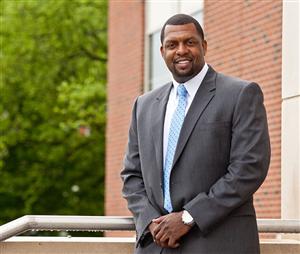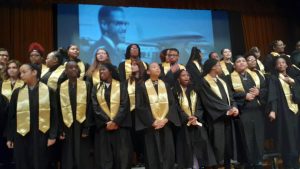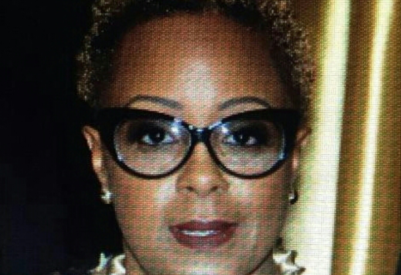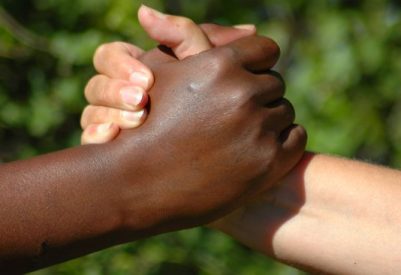
When East High School’s Superintendent Shaun Nelms accepted the new position created in 2015, by a partnership between the University of Rochester (U of R) and the Rochester City School District (RCSD), the embattled high school graduation rate bordered around nineteen percent. Today, East High’s graduation rate stands at seventy percent.
Nelms, position as East High’s superintendent, afforded him a significant role of overseeing the hiring of all administrative and staff positions, as well as the day-to-day operations.
Nonetheless, increased sovereignty is always accompanied with increased accountability. So, from a retrospective purview, the success or failure of the partnership will ultimately rest on the shoulders of Nelms and his leadership team.
“When the U of R called me and asked that I consider the job, my first response was I’m good,” Nelms said. “But every day, I thought about the opportunity to really prove that black and brown kids, when given the right resources can be successful. That challenge just became too attractive, because there was nothing else, I wanted to prove in education more passionately than, ``our kids can do anything that they want to do, if we give them the right resources and support.”
Four years later into Nelms tenure, as an invited guest at East High’s 2020 Annual Black History program, I got to see first-hand what having the right resources and support could compute into.
When we entered the auditorium, where the program was being held, you could feel a pulsating energy of a close-knit family circulating among students, faculty and staff members that grew exponentially, when Dr. Nelms, their leader, stepped through the door.
East High’s tailored modeled style of leadership is composed of ‘self-awareness’ which generates ‘self-empowerment’ that eventually produces and encourages each student to have or develop a voice, which sets the stage for any visitor to perceive a sensory experience that clearly reveals that the faculty, staff, and Nelms, all shares a mutual relationship with the students that’s founded on trust and respect.
As I sat down, I observed the students proudly strolling around in their school colors, meshing with each other, as if they were biological brothers and sisters.
It was also then I realized it was going to be one of those programs that will affect me deeply and soon everyone is going to be saying, who’s that guy in the front row tearing up through the entire event.
The program allowed the opportunity for the kids to showcase their talent, like a talent show. The kids are able to showcase their talent in any of the various arts including singing, poetry, dancing, storytelling, lecturing and as a musician. However, whatever they decided to do on this day, had to have a Black History theme, which included not only their voices on what they were presenting, but also the many voices of their ancestors, who were on the frontlines in the struggle in demanding that America fully recognize the legality of its black population God given human and civil rights.
One common denominator, I saw throughout the program in all categories was students, who had developed individual voices and centers of thought, also had a whole lot to say. They had a lot of substantial things to say! A lot of substantial things to sing about! Dance about! Lecture about! Play their trumpets, saxophones and drums about!
I witnessed students, who were consciously aware about who they were and where they wanted to go. Students, who trust and believe in their education system and exerted a feverish passion for learning!
I was witnessing what Nelms said would happen, when black and brown kids are given the right resources and support. So, I was tearing up, before the show started. The choir was just standing on stage, waiting on their que.

I guessed Nelms got tipped off, so he began poking me in the shoulder trying to get me to turn around, so he could see me teared-up. However, by-the-time we got halfway into the program, he had also joined the Former NBA Star Michael Jordan crying meme club.
When I asked Nelms, how did they do it among the resources?
He stated, the most important change is the process; which is getting teachers to truly believe, they have the ability to change the conditions for our students and work with our students to have faith in the education system believing that it is not designed for them to fail, but instead succeed and for our administers to share ownership in decision making, but also understanding, they are held accountable for the decisions they make.
Nelms continued.
“Then, you start to have systems for students to have a voice and teachers collaborating more often to make decisions around the curriculum. And, you don’t do that by making people work harder, but by getting people to work smarter and investing in the work they are doing. We see a decrease in our dropout rate, and an increase in attendance,” he recalled. “When we got here, only five percent of the students attending East resided within the neighborhood. Now, thirty-five percent of our students live within our neighborhood. The community will tell you, when they are not happy, by not attending. Parents don’t come to events, the kids don’t come to school and when they do come, they act up. Today, when you walk through East High, you see kids who are really proud, where they attend. Students are wearing East colors every day. You really can tell, they believe the school is theirs, to a point when we don’t do our job as adults, they call us out on it, which they should. Because, it’s their school. It’s their environment.”
Nelms also noted, if it wasn’t for the U of R, he would not have taken the job.
He views, the U of R as not just a school of education, but also as a business, where he would have access to some of the smartest minds in the region, when making hard decisions and access to the university’s donors, who could provide opportunities for the students at East.
“When they created this project, they told me that this was not a school of education project, this is a U of R project, so I had access to every single member in the U of R,” Nelms pointed-out. “So, if you visit East today, you see a medical center on campus and The Eastman Institute of Oral Health. We have two dental chairs on campus and The Eye Institute,” he points out. “You’ve a full university partnership.”
Nelms also believes, there should be more partnerships with local universities with RCSD low-performing schools.
“In most systems, where you have low performing schools, you have some of the best universities and colleges involved in getting them back on track,” Nelms said. “These types of partnerships are a good way to go, because it benefits both the university and the school. The U of R is better as a university because of this partnership,” he said. “They will tell you that. The way in which they now teach their students in the education courses has changed the entire syllabus and curriculum based on what they learned at East. It wouldn’t have happened without this project.”
The continued success of East High students, because of the partnership between the U of R and the RCSD, not only is chartering a blueprint for other low-performing schools in the RCSD, but it also affirmed Nelms passionate belief that black and brown kids can succeed if given the right resources and support.
The success of the partnership also affirms Nelms criticism of the traditional thought-scheme of those who see multiculturalism as a ‘compassionate’ benefit for black and brown kids.
In regard to the term, Nelms don’t believe that black and brown kids can only be successful, if they are seated by white kids. He thinks that’s a misconception about multiculturalism and integration.
“If we had equitable resources, the same learning opportunities and access outside of school to clubs, activities, museums and arts, I think kids would be successful anyway,” he emphasized. “Now that being said, I don’t think it’s anything wrong. I think it's great to have kids from all walks of life to be in the same space. But, it’s two separate conversations. Do I believe in multiculturalism to have kids work together? Absolutely. I think it’s great for people to learn from others unlike them of different religions, experiences and context. I think that’s, how you become a better human, a better person. But, if people are integrating solely to say, you’re putting black and white people in the same room, so black kids will benefit, then I think that’s a wrong perspective. I think that marginalizes the gift and talents of black and brown kids and young black and brown youth, when you make that assumption,” he strongly implied. “I think multiculturalism is a beautiful thing, but I think it’s a beautiful thing if everyone comes to the table with equal resources and equal abilities and it’s not being done because someone wants to be a martyr or they think it’s their civic duty to help these poor black and brown kids.”
Article by: Author Rodney Brown, Executive Director of Southwest Tribune Newspaper and Brown Publishing LLC





